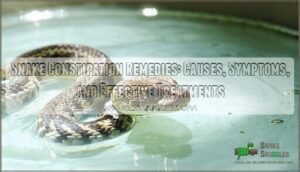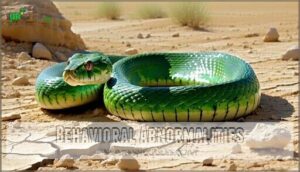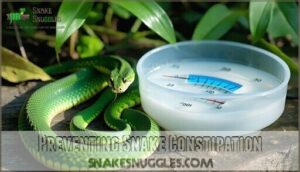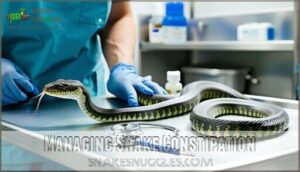This site is supported by our readers. We may earn a commission, at no cost to you, if you purchase through links.

A gentle belly massage, moving from head to tail, can also encourage movement. Check that their enclosure has proper heat (75-85°F) and humidity (50-60%) since these conditions aid digestion.
Provide fresh water daily and avoid overfeeding; smaller prey items are often easier to digest. If these steps don’t work or the issue worsens, consult a reptile vet. Proper care guarantees smoother slithering ahead, with a warm water soak and proper heat and humidity.
Table Of Contents
- Key Takeaways
- Recognizing Snake Constipation
- Causes of Snake Constipation
- Understanding Snake Impaction
- Preventing Snake Constipation
- Optimal Snake Nutrition
- Environmental Factors for Digestive Health
- Managing Snake Constipation
- Supplements and Snake Digestive Health
- Advanced Care for Constipated Snakes
- Treatment and Remedies for Snake Constipation
- Frequently Asked Questions (FAQs)
- How to help a snake with constipation?
- How do you treat a constipated reptile?
- How can I tell if my snake is constipated?
- What is the fastest thing to use for constipation?
- How do you stop a snake from getting constipated?
- How do you get rid of a snake poop?
- Can Snakes get constipated?
- How do you know if a snake is constipated?
- Can snakes pass impaction without veterinary intervention?
- How long should warm water soaks last?
- Conclusion
Key Takeaways
- Soak your snake in warm water (85-90°F) for 15-30 minutes daily to relax muscles and encourage bowel movements.
- Maintain proper enclosure conditions with a temperature gradient (75-85°F) and humidity between 60-70%.
- Offer fresh water daily, avoid overfeeding, and feed appropriately sized prey for easier digestion.
- If constipation persists or symptoms worsen, consult a reptile vet promptly for professional treatment.
Recognizing Snake Constipation
You can recognize snake constipation by observing changes in behavior, like sluggishness, loss of appetite, or unusual aggression.
Sluggish behavior, appetite loss, or sudden aggression could signal snake constipation—early detection ensures a healthier, happier pet.
Physical signs, such as a swollen, firm abdomen or lack of defecation for more than two weeks, also indicate a problem.
Lack of Bowel Movement
A snake’s poop schedule offers clues about their health.
Healthy snakes typically defecate 4-7 days after eating.
If your pet hasn’t pooped in over two weeks, constipation might be the issue.
Keep an eye on these signs:
- Stool Frequency: Long gaps between bowel movements or missed defecation.
- Feces Consistency: Dry, hard droppings or irregular texture.
- Appetite Changes and Abdominal Swelling: Loss of appetite or a bloated belly.
Address constipation promptly with vet-approved snake constipation remedies if symptoms persist.
Delays could lead to severe snake digestive issues or impaction.
Don’t ignore unusual stool patterns or behavior.
Behavioral Abnormalities
Changes in your snake’s behavior can hint at problems.
Sudden aggression, hiding excessively, or erratic movements may signal constipation.
Watch for unusual basking habits; constipated snakes often seek warmth to aid digestion.
Regurgitation issues could also arise from discomfort.
These snake behavioral abnormalities suggest the need for snake constipation remedies, including home remedies like warm water soaks or, if needed, veterinary intervention or surgery.
Lethargy and Loss of Appetite
Low energy levels and a sudden loss of appetite are common lethargy signs in snakes and often signal digestive issues like constipation.
Appetite causes can include stress, poor hydration, or dietary changes.
If your snake refuses food for over two weeks, monitor its hydration impact and consider snake constipation remedies, like adjusting temperature or humidity.
Persistent issues need a vet’s attention to rule out serious problems.
Irritability During Handling
When a snake faces constipation, handling stress may cause dramatic temperament changes.
You might notice defensive behavior like tight coiling, frequent hissing, or striking—a pain response signaling discomfort.
These behaviors stem from irritation caused by digestive issues.
Adjusting snake handling routines and practicing stress reduction can minimize irritation, creating time for snake constipation remedies to take effect and improve your pet’s well-being.
Physical Changes in The Abdomen
When your snake is constipated, its body gives visible red flags you can’t ignore. A snake with abdominal swelling may look like it swallowed a golf ball, and its firm belly feels unusually hard to the touch.
A typical sign of serious snake constipation symptoms is a distended belly with a palpable mass near the vent area. Check for scale distention, where stretched scales hint at bloating.
Feel carefully for these signs:
- Vent protrusion or bulging near the vent
- Abdominal swelling that feels tight or firm
- Unmoving bulge along the body
- Unusual color changes in the swollen area
- Scales stretched tighter than normal
Seek veterinary help quickly.
Causes of Snake Constipation
Snake constipation often stems from common issues like dehydration, low temperatures, or improper humidity levels. Other factors include overfeeding, parasitic infections, or accidental ingestion of harmful substrate materials.
Dehydration and Inadequate Water
Your snake’s hydration needs are simpler than you think.
Freshwater, soaking dishes, or misting help maintain healthy digestion and prevent snake constipation.
Dehydration thickens stool, slowing elimination and causing discomfort.
So, always offer fresh water daily.
Try soaking prey or misting regularly to boost hydration methods.
Humidity is also essential—dry environments lead to harder stools.
A proactive hydration routine is the best snake constipation remedy, keeping your pet healthy and stress-free.
Low Temperature and Humidity
A drop in enclosure temperatures below 75°F slows your snake’s metabolism, making digestion sluggish.
Pair that with low humidity, and waste material hardens, leading to constipation.
Use temperature gradients of 75-85°F and monitor humidity at 60-70% to prevent issues.
Without proper hydration methods and humidity monitoring, shedding problems can arise too.
Make certain good enclosure ventilation to maintain stable conditions that support healthy digestion and prevent reptile constipation effectively.
Substrate Impaction
Inside your snake’s habitat, substrate ingestion can pose serious risks.
Particles like sand or gravel may lead to impaction, a severe form of snake constipation. Stick to snake safe substrates such as reptile carpet or newspaper to reduce ingestion risks.
Proper substrate selection matters for preventing health issues. Feeding on a separate plate also helps.
Watch for signs like reduced appetite and bloating—severe cases might even require surgical removal to guarantee your snake’s health.
Overfeeding and Obesity
Overfeeding can lead to snake obesity, slowing digestion and increasing the risk of constipation.
To keep your pet healthy:
- Portion control is key; prey shouldn’t exceed 1.5x their body width.
- Monitor feeding frequency to match your snake’s needs.
- Track weight regularly for weight management.
- Avoid common obesity risks by offering proper prey size.
Monthly weigh-ins help guarantee healthy growth and digestion.
Severe Parasitic Infections
Parasites can disrupt digestion and cause snake constipation by inflaming the digestive tract.
Common signs of infestation include weight loss, lethargy, and unusual stool consistency.
Parasite types vary, entering snakes via prey or unsanitary conditions.
If you suspect an issue, collect fresh stool for diagnostic tests.
Early veterinary care, including probiotics or antibiotic treatment, is essential.
Prevention strategies, like sanitation and proper feeding, keep infections at bay.
Understanding Snake Impaction
Snake impaction happens when your snake can’t pass stool due to a severe blockage in its digestive system.
It’s a critical condition that may result from dehydration, low enclosure temperatures, or ingesting indigestible materials like substrate.
Definition and Symptoms
Snake impaction happens when stool gets stuck, causing your snake noticeable discomfort.
You might spot these tell-tale snake constipation symptoms:
- A bulge in their belly, often firm to the touch, signals ongoing abdominal swelling.
- They’ll refuse food entirely, a clear sign of appetite changes.
- Straining but failing to pass feces shows complications in stool consistency.
Watch for lethargy and behavioral shifts as well.
Causes and Risk Factors
Impaction often starts with dehydration, low temperatures, or improper substrates.
Dry environments can harden stools, while cold temperatures slow digestion. Some substrates, like sand or gravel, can lead to blockages if ingested during meals.
Overfeeding also strains the digestive system, causing constipation. Parasites disrupt bowel movements, making matters worse.
These snake constipation causes highlight why balancing environmental factors, diet, and hydration is essential to prevent serious reptile constipation causes like impaction.
Diagnosis and Radiography
In the context of spotting snake constipation, veterinarians often start with gentle palpation to feel for firm fecal masses, ensuring accuracy.
Digital radiographs are a go-to tool, offering clear imaging of blockages or foreign objects.
Contrast studies add depth by highlighting abnormal intestinal areas.
By interpreting x-rays effectively, vets can pinpoint problems and create a treatment plan customized to your snake’s needs, using tools like digital radiographs for clear imaging.
Pre-anesthetic Treatment and Surgery
Before surgery, your vet will perform a preoperative assessment to verify your snake is ready for anesthesia.
This includes reviewing blood work and confirming heart and oxygen health.
If surgery is necessary, they’ll carefully remove the blockage using specialized surgical techniques while monitoring anesthesia safety.
Here’s what to expect:
- Perform a thorough risk assessment.
- Confirm impaction using radiographs.
- Prepare your snake for anesthesia with hydration.
- Remove blockages during the surgical procedure.
- Focus on post-op recovery with pain management and infection control.
Preventing Snake Constipation
Preventing snake constipation starts with providing proper care, like maintaining the correct temperature, humidity, and hydration levels.
You should also monitor your snake’s diet, enclosure, and overall health to guarantee its digestive system stays in top condition, which is crucial for preventing snake constipation.
Providing a Temperature Gradient
A proper temperature gradient is essential for preventing snake constipation.
Set up a basking spot at 85-95°F, while the cooler side stays around 75-80°F.
This lets your snake regulate its body heat to aid digestion.
Use a reliable thermostat to monitor enclosure temperatures and adjust heat lamps carefully.
Keep your snake’s species temperature needs in mind, as improper gradients can cause digestive issues, impacting their health and comfort long-term, which is crucial for maintaining a healthy and comfortable environment for your snake to thrive, considering the importance of a proper basking spot.
Offering Fresh Water and Proper Substrate
Keeping your snake hydrated isn’t just a good habit; it’s a cornerstone of snake care tips.
Always provide fresh water in a dish large enough for soaking. Dirty water can lead to health problems, so refill it daily. Proper hydration can be aided by using a suitable water container.
Substrate selection matters too.
Avoid loose bedding like sand or bark chips that might be swallowed. Instead, use safe substrates like:
- Newspaper for easy cleanup.
- Reptile carpet for comfort and safety.
- Large bark pieces to support hydration.
- Paper towels for low-maintenance cleaning.
- Cypress mulch for maintaining humidity.
Avoiding Overfeeding and Obesity
Matching your snake’s prey size to its widest body part and sticking to a steady feeding frequency keeps digestion running smoothly.
Avoid overfeeding by watching their activity levels and using weight monitoring to check for changes.
For reference, here’s a quick guide:
| Snake Size | Feeding Frequency | Prey Size |
|---|---|---|
| Hatchling/Young | Every 5-7 days | Pinkies or small fuzzies |
| Juvenile | Every 7-10 days | Fuzzies or small rodents |
| Adult | Every 10-14 days | Larger rodents (proportional) |
Portion control prevents obesity, encourages movement, and reduces health risks.
Regular Observation and Veterinary Care
Keeping your snake healthy means being a vigilant observer.
Track eating, movement, and fecal patterns—early detection makes all the difference.
Regular vet checkups are a cornerstone of proactive healthcare, ensuring any hidden issues are uncovered.
Preventative care from a reptile specialist provides personalized guidance for snake health.
Simple steps like monitoring can prevent snake constipation, avoiding costly snake constipation treatment later.
Optimal Snake Nutrition
Feeding your snake the right prey in the correct portions is key to maintaining healthy digestion and preventing constipation.
A balanced diet suited to your snake’s species and size guarantees proper nutrition and keeps their digestive system functioning smoothly.
Choosing The Right Prey
Choosing the right prey keeps your snake healthy and problem-free.
Size matters—small enough to avoid strain but big enough to nourish.
Follow these tips:
- Select prey width matching your snake’s thickest body part.
- Use farm-raised prey to guarantee safety and ethical sourcing.
- Favor frozen prey over live for fewer injury risks and controlled feeding.
- Maintain variety with rodents like mice or rats for balanced nutritional content.
Smart prey choices promote smooth digestion.
Balancing Snake Nutrition
Balanced snake nutrition is key to avoiding digestive issues like constipation.
Feed younger snakes weekly and adults every 2-3 weeks for proper feeding frequency.
Gutload prey items to boost their nutritional value.
Address supplementation needs with calcium powder or vitamins if recommended, especially for breeders.
Watch for obesity risks—overfeeding disrupts digestion.
Align nutrition to prevent vitamin deficiencies while keeping your snake healthy.
Providing a Varied Diet
A varied snake diet supports proper nutrition and digestion, preventing constipation.
Incorporate diverse prey items to meet supplementation needs and encourage engagement.
- Feed different prey species like mice, rats, or chicks.
- Include appropriate prey size based on your snake’s width.
- Rotate between fresh or frozen-thawed prey.
- Adjust the feeding schedule to match the snake’s age and feeding frequency.
Environmental Factors for Digestive Health
Creating the right environment directly impacts your snake’s ability to digest food smoothly. By managing temperature, humidity, and lighting, you can support their health and prevent constipation effectively.
Temperature Gradient and Basking Spots
Snakes need the right temperature gradient for proper digestion. Set up a basking spot at 88-92°F on one side, ensuring a cooler zone on the other for thermoregulation.
Use heat lamps or mats with thermostats for consistent temperature regulation. A basking area about 1.5x your snake’s width works great.
A suitable reptile heat source is essential for maintaining these temperatures.
Here’s a quick guide:
| Temperature Zone | Recommended Range |
|---|---|
| Basking Spot | 88-92°F |
| Warm-End Gradient | 85-90°F |
| Cool-End Gradient | 75-80°F |
| Overnight Temps | 72-78°F |
| Enclosure Average | 80-85°F |
Humidity Levels and Hydration
Good hydration keeps digestion on track and prevents snake constipation.
Maintain humidity levels between 50-70% using misting system products or daily enclosure sprays.
Use a large water bowl with clean, species-appropriate water on the cooler side to avoid rapid evaporation.
Watch for shedding issues like stuck skin or wrinkling—these signal poor hydration, which can affect digestive health and overall comfort, ensuring a balance that guarantees comfort.
Stress Reduction Techniques
Stress can silently sabotage your snake’s health, including its digestion.
Creating a low-stress environment reduces digestive issues, promoting overall well-being. Focus on maintaining calm in your snake’s enclosure with these actionable tips:
- Add secure hides: Offer multiple hiding spots to help your snake feel safe.
- Minimize changes: Avoid frequently altering enclosure design during stress periods.
- Reduce handling: Handle your snake minimally during times of stress prevention.
- Choose a quiet area: Place the enclosure away from noisy or high-traffic spots.
These stress reduction techniques build a peaceful environment, critical for your snake’s comfort and health.
UVB Lighting for Vitamin D3 Synthesis
Supporting vitamin D3 production through proper UVB lighting boosts digestion and helps calcium absorption.
Keep UVB wavelengths consistent by replacing bulbs every 6-12 months. Position bulbs 10-12 inches above basking spots; distance impacts efficiency.
Stick to an 8-hour lighting schedule and monitor behaviors. Vitamin D3 and snake vitamin supplements fill gaps for better digestion.
| Key Aspect | Best Practice | Importance |
|---|---|---|
| UVB Wavelengths | Maintain ideal wavelengths | Supports D3 production |
| Bulb Lifespan | Replace every 6-12 months | Prevents inefficiency |
| Lighting Schedules | Use 6-8 hours daily | Guarantees proper exposure |
| Distance Impact | Set 10-12 inches from basking spot | Maximizes UVB absorption |
| Supplements | Add D3 and calcium if UVB is insufficient | Completes nutritional needs |
Managing Snake Constipation
To manage snake constipation effectively, you’ll need to focus on creating the right environment and closely monitoring your pet’s behavior.
Simple steps like adjusting temperature and hydration, providing warm baths, or seeking veterinary help can make a big difference.
Monitoring and Recording Behavior
Pay attention to your pet’s routines—it’s like opening a window into their world.
A digital health journal can track feeding responses, shedding patterns, and stool consistency.
Record changes in activity levels or interaction to catch early signs of trouble.
Here’s a quick checklist:
- **Log stool frequency and appearance.
- **Note shifts in routine or appetite.
- **Document unusual snake behavior promptly.
Adjusting Environment and Diet
Making small changes to your snake’s environment and diet can resolve constipation and keep things moving smoothly.
Here’s how to help with their digestion:
- Adjust the humidity to 60-70%.
- Use misting or hydration methods to keep the air moist.
- Create a temperature gradient (75-85°F on the cool side, 88-92°F at the basking spot).
- Switch to safe substrates like coconut fiber or paper towels to avoid impaction.
- Offer prey sized properly for their build and stick to a suitable feeding schedule.
Don’t forget—hydration and fresh water are essential!
Seeking Veterinary Care When Necessary
If your snake hasn’t pooped in over two weeks, it’s time for a veterinary consultation. Watch for warning signs like visible bulges, lethargy, or loss of appetite.
A reptile veterinarian may use diagnostic imaging to confirm issues or perform enema administration if needed. In severe cases, surgical options might save your snake.
Emergency vet care can range from $150-$500, but preventative vet visits help avoid complications. Don’t wait too long—your snake’s health depends on timely veterinary treatment.
Warm Water Baths and Gentle Massage
A warm bath and gentle massage can work wonders for snake constipation relief. Use warm water at 85-90°F (Bath Temperature) and let your snake soak for 15-20 minutes (Soak Duration). Then, massage its belly with light, head-to-tail strokes (Massage Technique).
Repeat baths twice daily (Bath Frequency) until you see improvement.
- Keep water shallow, below head level, for safety.
- Maintain consistent water temperature during the soak.
- Work gently, avoiding excess pressure during massage.
- Watch for stress signs like hissing or twitching.
- Don’t hesitate to contact a vet if symptoms persist.
Supplements and Snake Digestive Health
Supplements play a key role in supporting your snake’s digestion and preventing constipation. By using calcium, probiotics, and multivitamins, you can help maintain a healthy digestive system and overall wellbeing.
Calcium and Vitamin D3 for Bone Health
Strong bones and a healthy digestive system rely on proper levels of calcium and vitamin D3.
Snakes don’t synthesize D3 naturally like humans; they need UVB lighting or supplements to handle calcium absorption effectively.
Dusting prey with calcium powder, like Calcium Plus D3, prevents metabolic bone disease (MBD) and helps maintain bone density.
MBD weakens bones and disrupts digestion, so supplement dosage matters.
Feeding pre-killed prey? It’s even more important to use calcium-enriched powder regularly.
These steps support digestion and prevent health issues, keeping your snake active and free from preventable troubles.
Probiotics for Digestive Balance
Supporting your snake’s gut flora with probiotics can do wonders for its digestive balance.
These supplements introduce beneficial bacteria like Lactobacillus and Bifidobacterium to the gut, promoting better digestion and overall health.
Here’s how to get started:
- Choose trusted products: Look for probiotic strains designed specifically for reptiles.
- Follow dosage guidelines: Begin with a small dose and adjust gradually based on your snake’s response.
- Use during recovery: Supplements work well after antibiotics or during stress.
With safe administration, probiotics offer long-term benefits by maintaining digestive balance and preventing constipation.
Multivitamins and Minerals for Nutrition
Strong nutrition isn’t just about food—it’s also about the right vitamins and minerals.
Multivitamins and minerals, like Vitamin D3 and calcium sources, keep your snake’s gut microbiome balanced and prevent mineral deficiencies. Think of them as tiny helpers supporting digestion and overall health.
These trusted supplements can make a difference:
- ReptiVite: Boosts digestive and immune health.
- Herptivite: Enhances nutrient absorption and gut balance.
- Repashy Calcium Plus ICB: Maintains proper mineral intake.
- Zoo Med Reptile Vitamin: Aids digestion and organ health.
- Calcium Plus D3: Shields against metabolic bone disease.
Check supplement dosage and pair them with proper hydration for maximum impact!
Advanced Care for Constipated Snakes
If your snake’s constipation persists despite home remedies, it’s time to seek advanced veterinary care.
A reptile vet can assess the situation and recommend treatments like enemas, surgery, or other specialized interventions to guarantee your pet’s recovery.
Veterinary Intervention and Surgery
Veterinary intervention is essential when constipation becomes severe.
Diagnostic imaging helps identify blockages, while blood tests assess anesthesia risks. Veterinary surgery involves a precise incision for surgical removal of obstructions.
Though costly, these surgical options often save lives. Enema procedures may be considered first, but surgery remains essential for serious cases.
Trust experienced exotics vets for safe, effective treatment and minimized trauma.
Anesthesia and Post-Operative Care
During anesthesia and postoperative care, the vet minimizes surgical risks by monitoring protocols for breathing, heart rate, and muscle tone.
Pain management begins immediately after surgery, including fluids if dehydration occurs.
Verify your snake’s recovery environment stays quiet, clean, and warm.
Avoid feeding post-op until normal activity resumes.
Veterinary surgery requires diligence to guarantee smooth recovery and reduce anesthesia risks.
Follow-up Care and Preventative Measures
Proper follow-up prevents snake constipation from recurring. Monitor your snake’s activity and bowel patterns closely.
Focus on these steps for effective care:
- Hydration Practices: Keep fresh water available and mist the enclosure regularly.
- Enclosure Hygiene: Use safe substrates like paper towels and clean the habitat daily.
- Regular Checkups: Schedule periodic veterinary care to catch potential issues early.
Stick to consistent feeding schedules, maintain proper heat and humidity, and reduce stressors to improve your snake’s digestive health.
Treatment and Remedies for Snake Constipation
To help your constipated snake, focus on hydration, gentle massages, and warm water soaks to stimulate bowel movement.
In severe cases, veterinary care, including enemas or surgery, may be necessary to resolve the issue safely.
Lubrication and Rehydration
When your snake’s digestion slows, focus on lubrication and rehydration.
Lubrication and rehydration are key to stimulating your snake’s digestion and ensuring smooth, healthy bowel movements.
Try soaking them in warm water (85-90°F) or offering a diluted electrolyte solution. Apply a small amount of mineral oil near the vent to ease stool passing.
Keep their environment’s humidity and hydration ideal with fresh water and moist hides to support proper digestion.
| Action | Why It’s Important |
|---|---|
| Warm water soaks | Stimulates bowel movement |
| Electrolyte solution | Replenishes hydration |
| Mineral oil application | Eases stool passage |
| Check humidity levels | Prevents stool hardening |
| Fresh water availability | Maintains digestive health |
Enema and Massage Therapy
Enema administration and massage therapy are effective snake constipation remedies, but they must be done carefully to protect your pet.
Begin by soaking your snake in lukewarm water to soften stubborn stool. After soaking, use massage techniques by gently rubbing in a circular motion from head to tail, applying mineral oil or vet-approved lubricant.
Cloacal insertion or enemas should only be done by a veterinary expert to avoid harm. Never attempt advanced measures yourself without guidance.
Addressing snake digestive issues promptly guarantees their health and avoids further complications from constipation.
Surgery to Remove Impacted Feces
When nothing else works, surgery might be the only way to treat severe snake impaction.
Under anesthesia, a vet carefully removes the blockage, minimizing surgical risks.
Post-op care includes monitoring temperatures, adjusting diets, and ensuring hydration.
Recovery usually takes 2-3 weeks, though exact timelines depend on impaction severity.
Snake veterinary care costs range from $500 to $1500, so plan accordingly for the surgical risks.
Frequently Asked Questions (FAQs)
How to help a snake with constipation?
Feeling stuck? Start with warm water soaks (85-90°F) for 15-30 minutes daily to help stimulate bowel movements.
Gently massage the snake’s belly and make certain proper humidity, hydration, and temperature in its enclosure.
How do you treat a constipated reptile?
Warm water soaks (85-90°F) for 15-30 minutes daily can help relieve constipation in reptiles.
Gently massage their belly, make certain proper enclosure humidity, and always provide fresh water.
If symptoms persist, consult a reptile vet promptly.
How can I tell if my snake is constipated?
How can you tell if your snake’s feeling backed up?
Watch for signs like a swollen belly, lethargy, no poop for two weeks, or appetite loss.
Gentle belly checks reveal firmness, confirming possible constipation.
What is the fastest thing to use for constipation?
For quick relief, soak your snake in warm water (85-90°F) for 15-30 minutes.
The heat relaxes muscles and stimulates bowel movement.
Massage its belly gently from head to tail to encourage results.
How do you stop a snake from getting constipated?
Keep your slithery friend’s plumbing in check by providing fresh water daily, maintaining proper humidity and temperature, and using safe substrates.
Feed appropriately sized prey, avoid overfeeding, and regularly monitor their bowel habits for issues.
How do you get rid of a snake poop?
Dispose of snake poop by using disposable gloves to pick it up and place it in a sealed plastic bag.
Clean the area with a reptile-safe disinfectant to maintain hygiene and prevent bacteria buildup.
Can Snakes get constipated?
Yes, snakes can get constipated.
It happens when digestion slows due to dehydration, improper temperatures, or overfeeding.
You might notice bloating, lethargy, or no bowel movement for weeks.
Proper care and hydration usually help.
How do you know if a snake is constipated?
You’ll know your snake is constipated if it hasn’t pooped for over two weeks, shows bloating near its vent, becomes lethargic, stops eating, or strains without success.
Check for a firm, swollen belly too, as this can also be an indicator of constipation.
Can snakes pass impaction without veterinary intervention?
Ironically, snakes can’t always wiggle out of impaction on their own.
While mild cases might resolve with warm soaks and massages, severe blockages need a vet’s care to avoid life-threatening complications.
Don’t wait too long, as severe blockages can lead to serious issues.
How long should warm water soaks last?
Warm water soaks should last 15-30 minutes daily.
Make sure the water feels comfortably warm, around 85-90°F.
Keep your snake supervised to guarantee safety and help them relax during the process.
Conclusion
Proper prevention and care can combat constipation in snakes.
By maintaining the right temperature, humidity, and hydration, you’ll promote healthy digestion.
Provide fresh water, avoid overfeeding, and choose appropriate prey sizes.
If issues persist, don’t hesitate to consult a reptile vet for expert support.
Remember, snake constipation remedies like warm soaks and gentle massages often work wonders.
Prioritizing your snake’s health and habitat guarantees a content, active pet—and smoother slithering for the long haul, with healthy digestion and a good hydration.
























